Archive for January, 2014
Tuesday, January 14th, 2014
 One of America’s most important — and controversial — literary figures, Amiri Baraka, died on Thursday from complications after surgery following a long illness, according to his oldest son. Baraka was 79. One of America’s most important — and controversial — literary figures, Amiri Baraka, died on Thursday from complications after surgery following a long illness, according to his oldest son. Baraka was 79.
Baraka co-founded the Black Arts Movement of the 1960s. His literary legacy is as complicated as the times he lived through, from his childhood — where he recalled not being allowed to enter a segregated library — to the 2001 attack on the World Trade Center. His poem about that attack, “Somebody Blew Up America,” quickly became infamous.
They say its some terrorist,
some barbaric
A Rab,
in Afghanistan …
In that poem, Baraka hurls indictments at forces of oppression throughout history:
Who the biggest terrorist
Who change the bible
Who killed the most people
Who do the most evil
Who don’t worry about survival
Who have the colonies
Who stole the most land
Who rule the world
Who say they good but only do evil
The poem is a furious blaze of references, from the invasion of Grenada to the Jewish Holocaust, and conspiracies ranging from who shot Malcolm X to who killed Princess Di. Then, critics said, Amiri Baraka took it way too far:
Who knew the World Trade Center was gonna get bombed
Who told 4000 Israeli workers at the Twin Towers
To stay home that day
Why did Sharon stay away?
Who? Who? Who?
The poem had immediate consequences. Baraka was reviled even by former fans, and his post as the official state poet laureate of New Jersey was dissolved. A few years later, the host of the NPR show News and Notes pressed him about the incident, asking if he had any regrets.
“No — I have regrets that they didn’t pay me my money — cheap criminals. I have regrets about that,” Baraka said. “But I don’t have regrets about writing the poem. Because the poem was true.”
Over his life, Amiri Baraka would express an extremely broad range of beliefs — some offensive, some achingly beautiful. He was born in 1934, in Newark, N.J., as Everett LeRoi Jones. As a child, he was transfixed by poetry and music. He remembered the passing of musician Miles Davis for NPR, saying he wanted to be just like Davis as a teenager:
 I wanted to look like that too — that green shirt and rolled up sleeves on Milestones … always wanted to look like that. And be able to play “On Green Dolphin Street” or “Autumn Leaves” … That gorgeous chilling sweet sound. That’s the music you wanted playing when you was coming into a joint, or just looking up at the sky with your baby by your side, that mixture of America and them changes, them blue African magic chants. I wanted to look like that too — that green shirt and rolled up sleeves on Milestones … always wanted to look like that. And be able to play “On Green Dolphin Street” or “Autumn Leaves” … That gorgeous chilling sweet sound. That’s the music you wanted playing when you was coming into a joint, or just looking up at the sky with your baby by your side, that mixture of America and them changes, them blue African magic chants.
As a young man, the writer was part of New York’s then-mostly white Bohemian community. He hung out with Allen Ginsburg and Jack Kerouac — and wrote a book called Blues People that changed people’s ideas about the importance of African American culture, says scholar Kumozie Woodard.
“I think the Blues People might be his signature work. And that introduced jazz studies to the American academy,” Woodard says.
Then, in 1964, the writer still known as LeRoi Jones wrote a play, The Dutchman, which won a prestigious Obie award and established the playwright as a literary star. It’s set on a subway train, where a beautiful white woman strikes up a conversation with a young black man — and begins to tease him mercilessly. “You look like you live in New Jersey with your parents and are trying to grow a beard. That’s what. You look like you’ve been reading Chinese poetry,” she says.
But the teases become taunts, and the interaction grows ugly. Eventually, she stabs him in the heart. The play, said critics, expressed deep hostility towards women — a charge that followed the playwright for much of his life. After the murder of Malcolm X, he left his white wife and two daughters to live by radical black nationalist ideals.
He described it on NPR in 2007: “In the ’60s, after Malcolm’s death, black artists met and decided we were gonna move into Harlem and bring our art, the most advanced art by black artists, into the community.”
The Black Arts movement was a basically a counterpart to Black Power, and Baraka wrote a number of books now seen as foundational for a certain kind of black aesthetic and cultural identity. He converted to Islam, changed his name and in the 1970s, turned towards Marxism. His work would always emphasize social and political issues: “The people’s struggle influences art, and the most sensitive artists pick that up and reflect that,” he said.
Baraka’s work galvanized generations of younger artists, even as his stridency alienated him from the mainstream. But he managed to work in both worlds. He was a full professor for decades at SUNY Stony Brook, and he was recognized by the Guggenheim Foundation and the National Endowment for the Arts. At the same time, he ran a community arts center in Newark with his second wife. Professor Kumozie Woodard says all these roles — teacher, activist, artist, leader — came together as soon as you walked into Baraka’s front door.
“One time I came to his house and there was all this noise downstairs, and I asked him what it was, and he said it was a group of junior high school students who had a jazz history class downstairs,” Woodard says. “And then I heard noise upstairs, and I said, ‘What’s that?” and he said, ‘Well, the kids have taken over my office, and they have a newspaper.’ ”
In Baraka’s house — and throughout his life — the Black Arts Movement never stopped.
By Neda Ulaby
Originally published at NPR.org
Posted in Music News | 5 Comments »
Tuesday, January 14th, 2014
It doesn’t take an expert to identify this sound as a jazz rhythm:
Musicians call it “spang-a-lang,” for obvious phonetic reasons, and it’s so synonymous with jazz, it no longer occurs to us that someone had to invent it. But someone did: a drummer named Kenny Clarke, who would have turned 100 today.
Spang-a-lang was only part of Clarke’s innovation. Marking time on the ride cymbal with his right hand — previously, jazz drummers employed the bass drum with the right foot — gave his left hand and feet the freedom and sonic space to play thundering accents (“dropping bombs”) at irregular intervals. The sound they made inspired another phonetic term: “Klook,” which became Clarke’s nickname.
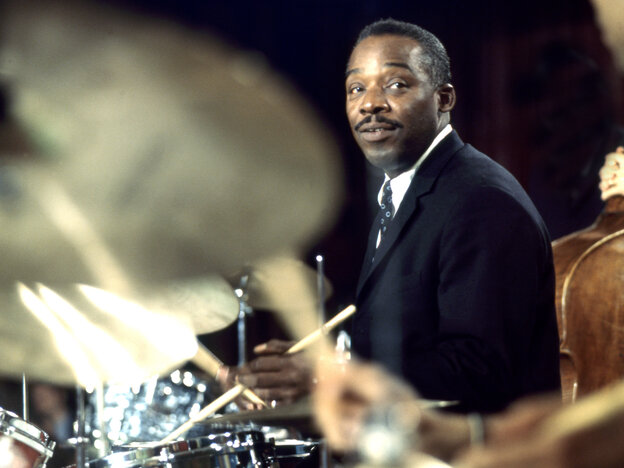 “Clarke represents a tectonic shift,” drummer and educator Ralph Peterson says. “He is the patriarch of drumming in modern jazz.” “Clarke represents a tectonic shift,” drummer and educator Ralph Peterson says. “He is the patriarch of drumming in modern jazz.”
Born in Pittsburgh in 1914, Clarke was a musical prodigy, drumming professionally with local big bands in his teens. By his 20s, he was working with Louis Armstrong and Roy Eldridge, superstars in their day.
This was the late ’30s: Jazz was still dance music, with the drums providing heavy beats for Lindy-hopping feet. Most drummers struck the bass on every beat in the measure, a technique known as four-on-the-floor. But as Clarke recalled to writer Ira Gitler in Swing to Bop, while playing with Teddy Hill’s big band one night in 1939, an arrangement of “Old Man River” went too fast for his foot to work the bass pedal. Instead, he kept the pulse going on the cymbal, using the bass and snare to “cut the time up.”
It was initially too weird for dancers and bandmates used to four-on-the-floor: Clarke was soon fired. But Teddy Hill remembered him in 1941, when recruiting the house band for a Harlem spot called Minton’s Playhouse. Minton’s became the laboratory for what would soon be called bebop or modern jazz — a less danceable, more abstract approach to the music — which was built substantially on Clarke’s rhythmic ideas. The classic tune “Epistrophy,” which Clarke wrote with pianist Thelonious Monk, is shaped like the bombs he dropped: an asymmetrical melody with accents placed irregularly, often just off the beat.
Clarke was drafted in 1943 and spent three years in the Army, thus personally missing out on bebop’s first public breakthrough. But its prime practitioners knew what he’d contributed, and when he was discharged, trumpeter and bebop pioneer Dizzy Gillespie installed Clarke in the rhythm section of his new big band. (That rhythm section later broke off and became the first incarnation of the Modern Jazz Quartet.)
As bebop gained predominance, Clarke became the most in-demand drummer on the scene — so much so that he began turning away work with major figures like Miles Davis. “Miles knocked on my door, so I told the little girl I was with to tell him I’m out,” Clarke told journalist Mike Zwerin. “I was tired, man.”
In 1956, he took a gig in Paris with pianist Michel Legrand. It was supposed to be a brief respite from New York; instead, Clarke stayed in Paris until his death in 1985. He was out of the American jazz limelight, but got to play music on his own terms. He played often with old friends from the U.S. who were passing through or similarly expatriated, and with the big band that he co-led throughout the 1960s with Belgian pianist Francy Boland.
Other drummers would refine his ideas, and often receive more credit as innovators. But it was Clarke who first established the rhythmic language that we recognize immediately as jazz today.
By Michael J. West
Originally published at NPR.org
Posted in Music News | 12 Comments »
Tuesday, January 14th, 2014
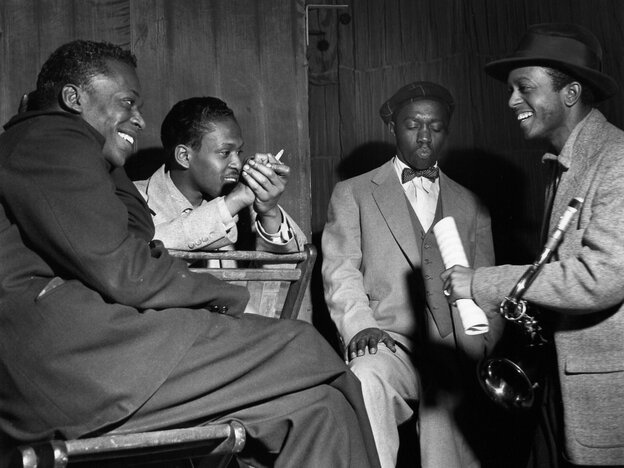 In the room he uses as a practice space and office in his apartment in Corona, Queens, Jimmy Heath recalls a hit record from long ago. In the room he uses as a practice space and office in his apartment in Corona, Queens, Jimmy Heath recalls a hit record from long ago.
“It’s a song Bill Farrell, a popular singer, had years ago,” he says, and then sings: “You’ve changed, you’re not the angel I once knew / No need to tell me that we’re through / It’s all over now, you’ve changed.” Then the 5’3″ musician with the big sound picks up his tenor saxophone and blows.
When “You’ve Changed” was a hit song in 1949, Heath was a 23-year-old bebopper, a disciple of the new jazz pioneered by alto saxophonist Charlie Parker and trumpeter Dizzy Gillespie. Heath played alto then, and already had his own big band in Philadelphia. John Coltrane was a sideman in Heath’s band, and at the end of 1949, they both joined the orchestra of their idol, Dizzy.
“We were actually second string beboppers,” Heath says. “Because we had heard Dizzy and Bird and they had set such a high curve to all of us who wanted to be like that — Trane and myself — we all were trying to be like them.”
Because he played alto in the style of Parker, whose nickname was Bird, and because he’s small in stature, Heath became known as Little Bird. When he left Dizzy’s band, he switched to tenor saxophone.
“I wanted to get away from being called Little Bird,” Heath says. “I liked the idea at first, but I wanted to be Jimmy Heath. So, I say, ‘Well, I’ll get the tenor and try this,’ and you know, lo and behold, I still sounded like Bird on tenor.”
But Jimmy Heath is more than an instrumentalist. He composes, arranges and orchestrates.
By Tom Vitale
Originally published at NPR.org
Posted in Music News | 4 Comments »
Thursday, January 9th, 2014
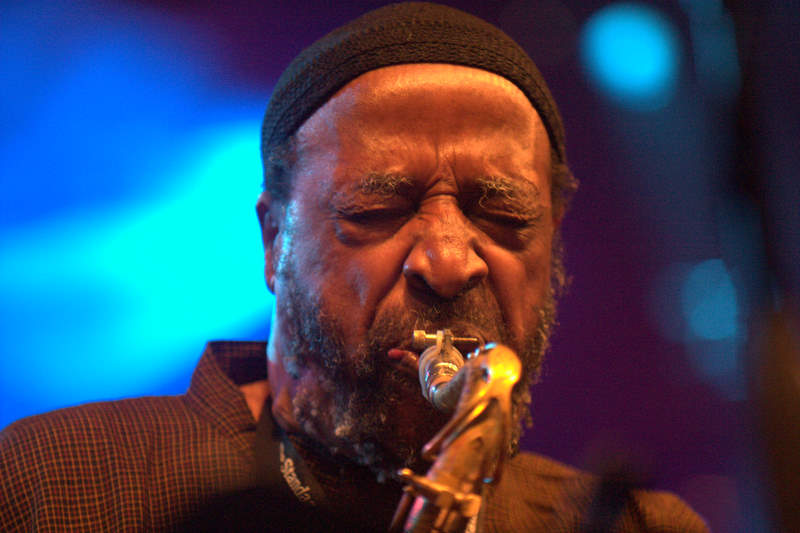 Few jazz musicians balanced intellect and instinct, head and heart, as effectively or seamlessly as Yusef Lateef, who died at 93 on Monday, at home in Massachusetts. His prescience and influence as a player and composer were mighty, and often go overlooked, maybe because his innovations resulted in such likable, lucid music, based often in sheer melody and modal groove. A tenorman who projected the sort of bluesy romance we associate with great midcentury hard bop, he became one of jazz’s best flutists, with a stately attack and a pulsating vibrato that gave his sound a breathy humanity. He also introduced into jazz the persona of the searching multireedist, employing unlikely wind instruments from around the world and proving the jazz worth of the oboe. More than most, he understood the importance of timbre: His oboe, with a beautiful woodiness warmer than the soprano sax but less sinister than the bass clarinet, wasn’t a substitute for his sax or flute; it had its own rules, its own charms, and he treated each horn in his arsenal with this specificity. Of course, he was jazz’s first true multiculturalist, whose musicological passion for Eastern musics cleared new paths for improvising musicians. He did all of this ahead of the curve, too. Yusef Lateef’s ’50s were everyone else’s ’60s. Few jazz musicians balanced intellect and instinct, head and heart, as effectively or seamlessly as Yusef Lateef, who died at 93 on Monday, at home in Massachusetts. His prescience and influence as a player and composer were mighty, and often go overlooked, maybe because his innovations resulted in such likable, lucid music, based often in sheer melody and modal groove. A tenorman who projected the sort of bluesy romance we associate with great midcentury hard bop, he became one of jazz’s best flutists, with a stately attack and a pulsating vibrato that gave his sound a breathy humanity. He also introduced into jazz the persona of the searching multireedist, employing unlikely wind instruments from around the world and proving the jazz worth of the oboe. More than most, he understood the importance of timbre: His oboe, with a beautiful woodiness warmer than the soprano sax but less sinister than the bass clarinet, wasn’t a substitute for his sax or flute; it had its own rules, its own charms, and he treated each horn in his arsenal with this specificity. Of course, he was jazz’s first true multiculturalist, whose musicological passion for Eastern musics cleared new paths for improvising musicians. He did all of this ahead of the curve, too. Yusef Lateef’s ’50s were everyone else’s ’60s.
As his NEA bio indicates—he was named a Jazz Master for 2010—Lateef was born William Emanuel Huddleston in Tennessee in 1920. When he was 5 his family moved to Detroit, and Lateef came up in that city’s rich scene. Early associations included Donald Byrd, the Jones brothers, Paul Chambers, Lucky Thompson and Kenny Burrell, and he spent much of his late teens and 20s in touring bands, under leaders including Roy Eldridge and Dizzy Gillespie. (Around age 30, he converted to Islam and became Yusef Lateef.) By the mid-to-late 1950s he was performing and recording as a leader, releasing a string of LPs on the Savoy label that tempered his developing global interests with the hard bop of the day. Based in New York by 1960, he gigged with Charles Mingus and for two years in the Cannonball Adderley Sextet.
All the while he continued releasing albums under his own name, including his most popular LP, the 1961 Prestige Moodsville date Eastern Sounds. A canonical recording, it features an overview of his key modes: On “The Plum Blossom,” he’s a seductive world rhythmist; on “Blues for the Orient,” a purveyor of exotic soul; and on “Love Theme From Spartacus” he relishes pure melody. Lateef’s proclivities and position as a lodestar to John Coltrane made him a natural fit for the Impulse! label, where he recorded from 1963 to ’66. His discography there again showcased his musical penchants in a state of equilibrium: Jazz ’Round the World applied a jazz process to global folk styles; A Flat, G Flat and C explored blues forms; The Golden Flute reiterated Lateef’s expertise on standards; for more of Lateef’s gorgeous way with melody, look no further than his take on Erik Satie’s “First Gymnopédie,” off 1965’s Psychicemotus. Lateef also had an enduring relationship with Atlantic, where he came to embody and subvert the times, sometimes on the same record: 1972’sHush ’N’ Thunder, heavy on material by Kenny Barron, traverses period jazz-funk (“The Hump”), patient, scorelike work (“Opus #1/Opus #2,” “Destination Paradise”) and even a noise experiment. For the Rhino Atlantic release Yusef Lateef’s Little Symphony, from 1987, he played all of the instruments via overdubbing and received a Grammy Award in the New Age category. (Lateef famously said he didn’t know what that genre implied, but he also felt great disdain for the term “jazz”—yet another example of his soothsaying. He took to calling his music “Autophysiopsychic” at one point, though his 1977 release with that name seemed to reflect its label, CTI, more than the artist.)
Throughout the ’90s and aughts he continued to forge vital collaborations, including a longstanding duo with the percussionist and composer Adam Rudolph. He also composed increasingly ambitious work. Case in point: Just last April, Lateef premiered through-composed music for strings, horns and piano in Brooklyn. He studied at Wayne State and earned a bachelor’s in music and master’s in music education from the Manhattan School. He also held a doctorate in education from UMass Amherst, where he taught for 15 years, among other teaching stints. Beyond music, his interests were myriad, extending into creative writing, the visual arts and owning a label. He was a Renaissance man whose personal renaissance never ended.
Originally published at jazztimes.com
Posted in Music News | Comments Off on Yusef Lateef Is Dead at 93
Thursday, January 9th, 2014
Jazz at Lincoln Center announced an unprecedented gift of $20 million from Robert J. Appel, the organizations Chairman of the Board of Directors.
Mr. Appels gift is the largest single private philanthropic contribution to date in support of jazz, and will benefit the thousands of performance, education and broadcast events Jazz at Lincoln Center produces each year. The gift also advances the organizations global objectives in audience development, engagement and jazz advocacy.
“Bob Appel’s gift to the organization is transformative,” said Wynton Marsalis, Jazz at Lincoln Center’s Managing and Artistic Director. “His expressed commitment to jazz and Jazz at Lincoln Center establishes a new standard of philanthropy for this great American art. The magnitude of this affirmation from our Chairman invigorates our entire institution, and encourages us to an even deeper and more profound engagement with our Mission.”
Mr. Appel was appointed Jazz at Lincoln Center’s Chairman of the Board of Directors in 2012. He became a member of the Board of Directors in 2008 and has actively served on various committees. He has been a private investor since 2003 and was formerly a partner of Neuberger Berman, an investment and securities brokerage firm. Mr. Appel has been recognized for his philanthropic work with his alma mater, Cornell University, The Weill Cornell Medical College and many other organizations. As Jazz at Lincoln Center’s Chairman, Mr. Appel works closely with the Board and Marsalis, on fundraising to maintain and further develop a myriad of national and international curatorial, educational and archival initiatives.
Originally published at jalc.org
Posted in Music News | 9 Comments »
Wednesday, January 1st, 2014
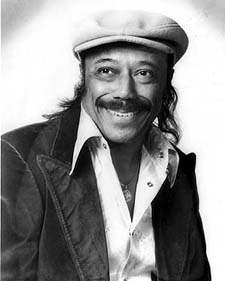 When Horace Silver once wrote out his rules for musical composition (in the liner notes to the 1968 record, Serenade to a Soul Sister), he expounded on the importance of “meaningful simplicity.” The pianist could have just as easily been describing his own life. For more than fifty years, Silver has simply written some of the most enduring tunes in jazz while performing them in a distinctively personal style. It’s all been straight forward enough, while decades of incredible experiences have provided the meaning. When Horace Silver once wrote out his rules for musical composition (in the liner notes to the 1968 record, Serenade to a Soul Sister), he expounded on the importance of “meaningful simplicity.” The pianist could have just as easily been describing his own life. For more than fifty years, Silver has simply written some of the most enduring tunes in jazz while performing them in a distinctively personal style. It’s all been straight forward enough, while decades of incredible experiences have provided the meaning.
Silver was born in Norwalk, Connecticut on September 2, 1928. His father had immigrated to the United States from Cape Verde—and that island nation’s Portuguese influences would play a big part in Silver’s own music later on. When Silver was a teenager, he began playing both piano and saxophone while he listened to everything from boogie-woogie and blues to such modern musicians as Bud Powell and Thelonious Monk. As Silver’s piano trio was working in Hartford, Connecticut, the group received saxophonist Stan Getz’s attention in 1950. The saxophonist brought the band on the road and recorded three of Silver’s compositions.
In 1951, Silver moved to New York City where he accompanied saxophonists Coleman Hawkins, Lester Young and many other legends. In the following year, he met the executives at Blue Note while working as a sideman for saxophonist Lou Donaldson. This meeting led to Silver signing with the label where he would remain until 1980. He also collaborated with Art Blakey in forming the Jazz Messengers during the early 1950s (which Blakey would continue to lead after Silver formed his own quintet in 1956).
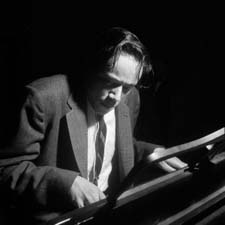 During these years, Silver helped create the rhythmically forceful branch of jazz known as “hard bop” (chronicled in David H. Rosenthal’s 1992 book, Hard Bop: Jazz and Black Music, 1955-1965). He based much of his own writing on blues and gospel—the latter is particularly prominent on one of his biggest tunes, “The Preacher.” While his compositions at this time featured surprising tempo shifts and a range of melodic ideas, they immediately caught the attention of a wide audience. Silver’s own piano playing easily shifted from aggressively percussive to lushly romantic within just a few bars. At the same time, his sharp use of repetition was funky even before that word could be used in polite company. Along with Silver’s own work, his bands often featured such rising jazz stars as saxophonists Junior Cook and Hank Mobley, trumpeter Blue Mitchell, and drummer Louis Hayes. Some of his key albums from this period included Horace Silver Trio (1953), Horace Silver and the Jazz Messengers (1955), Six Pieces of Silver (1956) and Blowin’ The Blues Away (1959), which includes his famous, “Sister Sadie.” He also combined jazz with a sassy take on pop through the 1961 hit, “Filthy McNasty.” During these years, Silver helped create the rhythmically forceful branch of jazz known as “hard bop” (chronicled in David H. Rosenthal’s 1992 book, Hard Bop: Jazz and Black Music, 1955-1965). He based much of his own writing on blues and gospel—the latter is particularly prominent on one of his biggest tunes, “The Preacher.” While his compositions at this time featured surprising tempo shifts and a range of melodic ideas, they immediately caught the attention of a wide audience. Silver’s own piano playing easily shifted from aggressively percussive to lushly romantic within just a few bars. At the same time, his sharp use of repetition was funky even before that word could be used in polite company. Along with Silver’s own work, his bands often featured such rising jazz stars as saxophonists Junior Cook and Hank Mobley, trumpeter Blue Mitchell, and drummer Louis Hayes. Some of his key albums from this period included Horace Silver Trio (1953), Horace Silver and the Jazz Messengers (1955), Six Pieces of Silver (1956) and Blowin’ The Blues Away (1959), which includes his famous, “Sister Sadie.” He also combined jazz with a sassy take on pop through the 1961 hit, “Filthy McNasty.”
But it was a few years later when Silver would record one of his most famous songs, the title track to his 1964 album, Song For My Father. That piece combined his dad’s take on Cape Verdean folk music (with a hint of Brazilian Carnival rhythms) into an enduring F-minor jazz composition. Over the years, it has become an American popular music standard, covered not only by scores of instrumentalists, but also such singers as James Brown.
As social and cultural upheavals shook the nation during the late 1960s and early 1970s, Silver responded to these changes through music. He commented directly on the new scene through a trio of records called United States of Mind (1970-1972) that featured the spirited vocals of Andy Bey. The composer got deeper into cosmic philosophy as his group, Silver ‘N Strings, recorded Silver ‘N Strings Play The Music of the Spheres (1979).
After Silver’s long tenure with Blue Note ended, he continued to create vital music. The 1985 album, Continuity of Spirit (Silveto), features his unique orchestral collaborations. In the 1990s, Silver directly answered the urban popular music that had been largely built from his influence on It’s Got To Be Funky (Columbia, 1993). On Jazz Has A Sense of Humor (Verve, 1998), he shows his younger group of sidemen the true meaning of the music.
Now living surrounded by a devoted family in California, Silver has received much of the recognition due a venerable jazz icon. In 2005, the National Academy of Recording Arts and Sciences (NARAS) gave him its President’s Merit Award. Silver is also anxious to tell the world his life story in his own words as he just completed writing his autobiography, Let’s Get To The Nitty Gritty (University of California Press, scheduled for fall 2006 release).
Originally published at horacesilver.com
Posted in Artist of the Month | 4 Comments »
|
 One of America’s most important — and controversial — literary figures, Amiri Baraka, died on Thursday from complications after surgery following a long illness, according to his oldest son. Baraka was 79.
One of America’s most important — and controversial — literary figures, Amiri Baraka, died on Thursday from complications after surgery following a long illness, according to his oldest son. Baraka was 79. I wanted to look like that too — that green shirt and rolled up sleeves on Milestones … always wanted to look like that. And be able to play “On Green Dolphin Street” or “Autumn Leaves” … That gorgeous chilling sweet sound. That’s the music you wanted playing when you was coming into a joint, or just looking up at the sky with your baby by your side, that mixture of America and them changes, them blue African magic chants.
I wanted to look like that too — that green shirt and rolled up sleeves on Milestones … always wanted to look like that. And be able to play “On Green Dolphin Street” or “Autumn Leaves” … That gorgeous chilling sweet sound. That’s the music you wanted playing when you was coming into a joint, or just looking up at the sky with your baby by your side, that mixture of America and them changes, them blue African magic chants.

 “Clarke represents a tectonic shift,” drummer and educator Ralph Peterson says. “He is the patriarch of drumming in modern jazz.”
“Clarke represents a tectonic shift,” drummer and educator Ralph Peterson says. “He is the patriarch of drumming in modern jazz.” In the room he uses as a practice space and office in his apartment in Corona, Queens, Jimmy Heath recalls a hit record from long ago.
In the room he uses as a practice space and office in his apartment in Corona, Queens, Jimmy Heath recalls a hit record from long ago. Few jazz musicians balanced intellect and instinct, head and heart, as effectively or seamlessly as Yusef Lateef, who died at 93 on Monday, at home in Massachusetts. His prescience and influence as a player and composer were mighty, and often go overlooked, maybe because his innovations resulted in such likable, lucid music, based often in sheer melody and modal groove. A tenorman who projected the sort of bluesy romance we associate with great midcentury hard bop, he became one of jazz’s best flutists, with a stately attack and a pulsating vibrato that gave his sound a breathy humanity. He also introduced into jazz the persona of the searching multireedist, employing unlikely wind instruments from around the world and proving the jazz worth of the oboe. More than most, he understood the importance of timbre: His oboe, with a beautiful woodiness warmer than the soprano sax but less sinister than the bass clarinet, wasn’t a substitute for his sax or flute; it had its own rules, its own charms, and he treated each horn in his arsenal with this specificity. Of course, he was jazz’s first true multiculturalist, whose musicological passion for Eastern musics cleared new paths for improvising musicians. He did all of this ahead of the curve, too. Yusef Lateef’s ’50s were everyone else’s ’60s.
Few jazz musicians balanced intellect and instinct, head and heart, as effectively or seamlessly as Yusef Lateef, who died at 93 on Monday, at home in Massachusetts. His prescience and influence as a player and composer were mighty, and often go overlooked, maybe because his innovations resulted in such likable, lucid music, based often in sheer melody and modal groove. A tenorman who projected the sort of bluesy romance we associate with great midcentury hard bop, he became one of jazz’s best flutists, with a stately attack and a pulsating vibrato that gave his sound a breathy humanity. He also introduced into jazz the persona of the searching multireedist, employing unlikely wind instruments from around the world and proving the jazz worth of the oboe. More than most, he understood the importance of timbre: His oboe, with a beautiful woodiness warmer than the soprano sax but less sinister than the bass clarinet, wasn’t a substitute for his sax or flute; it had its own rules, its own charms, and he treated each horn in his arsenal with this specificity. Of course, he was jazz’s first true multiculturalist, whose musicological passion for Eastern musics cleared new paths for improvising musicians. He did all of this ahead of the curve, too. Yusef Lateef’s ’50s were everyone else’s ’60s. When Horace Silver once wrote out his rules for musical composition (in the liner notes to the 1968 record, Serenade to a Soul Sister), he expounded on the importance of “meaningful simplicity.” The pianist could have just as easily been describing his own life. For more than fifty years, Silver has simply written some of the most enduring tunes in jazz while performing them in a distinctively personal style. It’s all been straight forward enough, while decades of incredible experiences have provided the meaning.
When Horace Silver once wrote out his rules for musical composition (in the liner notes to the 1968 record, Serenade to a Soul Sister), he expounded on the importance of “meaningful simplicity.” The pianist could have just as easily been describing his own life. For more than fifty years, Silver has simply written some of the most enduring tunes in jazz while performing them in a distinctively personal style. It’s all been straight forward enough, while decades of incredible experiences have provided the meaning. During these years, Silver helped create the rhythmically forceful branch of jazz known as “hard bop” (chronicled in David H. Rosenthal’s 1992 book, Hard Bop: Jazz and Black Music, 1955-1965). He based much of his own writing on blues and gospel—the latter is particularly prominent on one of his biggest tunes, “The Preacher.” While his compositions at this time featured surprising tempo shifts and a range of melodic ideas, they immediately caught the attention of a wide audience. Silver’s own piano playing easily shifted from aggressively percussive to lushly romantic within just a few bars. At the same time, his sharp use of repetition was funky even before that word could be used in polite company. Along with Silver’s own work, his bands often featured such rising jazz stars as saxophonists Junior Cook and Hank Mobley, trumpeter Blue Mitchell, and drummer Louis Hayes. Some of his key albums from this period included Horace Silver Trio (1953), Horace Silver and the Jazz Messengers (1955), Six Pieces of Silver (1956) and Blowin’ The Blues Away (1959), which includes his famous, “Sister Sadie.” He also combined jazz with a sassy take on pop through the 1961 hit, “Filthy McNasty.”
During these years, Silver helped create the rhythmically forceful branch of jazz known as “hard bop” (chronicled in David H. Rosenthal’s 1992 book, Hard Bop: Jazz and Black Music, 1955-1965). He based much of his own writing on blues and gospel—the latter is particularly prominent on one of his biggest tunes, “The Preacher.” While his compositions at this time featured surprising tempo shifts and a range of melodic ideas, they immediately caught the attention of a wide audience. Silver’s own piano playing easily shifted from aggressively percussive to lushly romantic within just a few bars. At the same time, his sharp use of repetition was funky even before that word could be used in polite company. Along with Silver’s own work, his bands often featured such rising jazz stars as saxophonists Junior Cook and Hank Mobley, trumpeter Blue Mitchell, and drummer Louis Hayes. Some of his key albums from this period included Horace Silver Trio (1953), Horace Silver and the Jazz Messengers (1955), Six Pieces of Silver (1956) and Blowin’ The Blues Away (1959), which includes his famous, “Sister Sadie.” He also combined jazz with a sassy take on pop through the 1961 hit, “Filthy McNasty.”